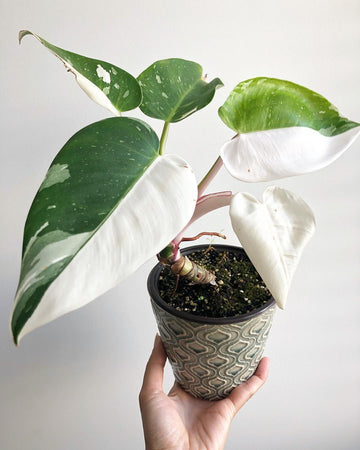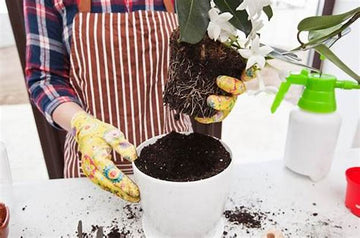Monstera albo (Monstera deliciosa 'Albo Borsigiana') is a rare and elusive plant that many plant collectors love and adore. This variegated monstera is at the top of many wish lists worldwide thanks to its stunning variegation and prestige reputation—with these plants often selling for several hundred or thousands of dollars. These trendy plants are in high demand from online plant sellers.
Monstera albo is a subspecies of the popular Monstera deliciosa, characterized by large patches of white, naturally occurring variegation on split leaves. It is a slow-growing tropical plant that grows best in bright, indirect light, moist, rich, well-draining soil, warm temperatures, and higher humidity environments. Note that it is toxic to pets.
Monstera Albo Care
Native to the tropical rainforests of Central America, these popular, showy houseplants grow well in most indoor conditions. If you’ve cared for a Monstera deliciosa before, then you already have a great head start since caring for the albo is pretty similar. Monstera albo are known for being a bit high-maintenance, so there are a few differences to keep in mind.
Here are the main care requirements for growing monstera albo:
- Provide at least six hours of filtered, indirect light.
- Give it rich, well-draining soil.
- Irrigate when its soil starts feeling dry.
- Keep temperature between 65 and 80 F and at least 60% humidity.
- It needs regular fertilizer, but be careful not to over-fertilize.

Light
To keep its variegation bright and plentiful, provide your monstera albo with lots of bright, indirect light. At least six to seven hours of filtered light is recommended.
Keeping these plants out of direct sunlight is essential as the variegated parts of their leaves are extra sensitive to sunburn. If monstera albos do not get enough light, they will start to lose their variegation, so they are not good low-light plants.
Soil
A rich, well-draining soil mix is essential. A combination of equal parts perlite, orchid bark, coco peat, and coco coir will provide the drainage and nutrients that monstera albos require. Mixing in some natural fertilizers like worm castings is also a good idea and will give an extra boost.
Water
These tropical plants are susceptible to root rot if overwatered, so letting the soil dry slightly between waterings is essential. Allow the top 1 to 2 inches of soil to dry, then water well, allowing the excess water to drain from the pot’s drainage holes.
Temperature and Humidity
As with other plants in the Monstera genus, the albo does best in warm temperatures, ideally between 65 to 80 degrees Fahrenheit. This makes it well-suited to indoor growing, although it can also be grown outdoors during the summer or year-round in USDA zones 9 to 11.
They do best with at least 60 percent humidity, generally higher than most household humidity levels. That means you will likely need to provide added humidity, which can be done by placing a humidifier nearby, grouping it with other plants, or moving it to a naturally humid room like a bathroom or kitchen.
Fertilizer
To produce their variegated foliage albos require more diligent feeding than regular Monstera deliciosas. These monsteras are also susceptible to over-fertilizing, so getting it just right is essential.
Use a potting mix enriched with natural fertilizers and feed your plant once a month with a balanced liquid fertilizer, following product label instructions. Stop feeding altogether during the fall and winter months when the plant is no longer actively growing.
Types of Monstera Albo
If you can't find one type of Monstera albo, try others, each with their unique silhouette and variegated patterns.
- Monstera deliciosa 'Albo Variegata': Deep green and cream leaves
- Monstera adansonii 'Albo Variegata': Very rare with many holes per each cream and green split leaves.
- Monstera deliciosa 'Albo Borsigiana': Large, mostly white leaves with some green
- Monstera adansonii f. variegata Variegated Laniata Albo: Tri-colored dark green, light green, and white leaves, some with a glossy finish
-
Monstera Marbled Albo: Rarest with distinct splotches of white and green with deeply split leaves
Pruning
Monstera albo does not require pruning beyond removing dying yellow leaves. If the plant has overgrown and needs trimming, it is best to do it in the growing season during vigorous growth.
To trim, sanitize the tools and cut above the growing nodes. Water well after pruning, and do not fertilize immediately afterward.
Encourage your monstera albo to grow large, healthy leaves by providing it with a moss pole. These vining plants climb trees naturally and do well when given a moss pole to climb indoors.
Propagating Monstera Albo
Since their stunning white variegation is naturally occurring, stem cutting is the only way to produce more of these amazing plants. It is pretty simple to propagate and is nearly identical to propagating regular Monstera deliciosa, although variegated monsteras take much longer than regular monsteras, so be patient.
It is also common to purchase these variegated monsteras as new or established stem cuttings, so if you are looking for tips on how to care for your new monstera albo cutting, you can also follow these steps:
- Using a pair of sterilized sharp pruning shears or scissors, take a stem cutting from a healthy monstera albo. Ideally, the stem cutting should contain at least one to three nodes along the stem with at least as many leaves.
- Remove the bottom one to two leaves from the cutting to expose the nodes at the bottom of the stem, and leave at least one leaf at the top of the cutting.
- Next, you must decide which medium you will root your cutting in. You can choose sphagnum moss, water, leca (lightweight expanded clay aggregate), or perlite.
- Prepare a small container with your chosen medium. Note that sphagnum moss, leca, and perlite should all be pre-moistened and remain consistently damp throughout the rooting process.
- Add your cutting to your prepared medium, ensuring that the exposed nodes at the bottom of the cutting are submerged in the medium and the remaining leaves are not.
- Place your cutting in a location that receives bright, indirect light. Roots should begin to start growing over the next few weeks. Keep your rooting medium consistently moist, or change the water once a week if you are rooting in water.
- Once roots are at least 2 to 3 inches long, you can transfer your rooted cutting to a rich and well-draining potting mix. Pre-moisten the soil and plant your cutting.
- Return your potted cutting to bright, indirect light and keep the soil evenly moist for the first one to two weeks to help the plant acclimate.
Potting and Repotting Monstera Albo
These monsteras are slow-growing and will likely only need to be repotted every two to three years. It is best to repot your monstera albo in the early to late spring or in the summer. Avoid repotting in the fall or winter months as the plant enters dormancy. Choose a pot one size larger than the previous pot or 2 to 3 inches larger in diameter.
The first step is to carefully remove the plant from its old pot and loosen the rootball as much as possible without breaking any roots. You want to remove as much of the old soil as possible. Next, place the plant's root ball in the new pot, cover it with fresh potting mix, and then water it well. Return it to its original location and resume its regular watering schedule.




